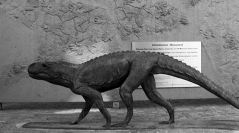

 Comptes Rendus Palevol
8 (4) - Pages 427-436
Comptes Rendus Palevol
8 (4) - Pages 427-436Despite a certain interest in the discipline, Alexander von Humboldt did not personally contribute much to the progress of palaeozoology. His most remarkable input derived from a communication about hand-like archosaur footprints from the Buntsandstein at the very acme of the important controversy that the discovery of these fossils generated (1835). Humboldt thought that the tracks were probably from a possum-like marsupial, but he did not discount that they could be from a primate. This study is characterized by its superficiality: both the anatomical comparisons and the considerations of the functional morphology of locomotion are very poor. Its effect on the scientific community proved about nil, in both the short and the long run, and Humboldt may himself have doubted his initial conclusions in later years. Nevertheless, in contrast with some contemporaneous renowned geognosts, he had no hesitation from the beginning that the footprints were genuine. He also did not hesitate to weaken the belief of the time on the timing of the succession of organised beings in geological ages, naturally without lapsing into “antiprogressionism”.
Humboldt, History of science, Ichnology, Triassic, Germany